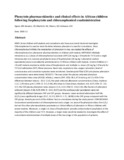| dc.description.abstract | AIMS:
Some children with malaria and convulsions also have concurrent bacterial meningitis. Chloramphenicol is used to treat the latter whereas phenytoin is used for convulsions. Since chloramphenicol inhibits the metabolism of phenytoin in vivo, we studied the effects of chloramphenicol on phenytoin pharmacokinetics in children with malaria.
METHODS:
Multiple intravenous (i.v.) doses of chloramphenicol succinate (CAP) (25 mg kg-1 6 hourly for 72 h) and a single intramuscular (i.m.) seizure prophylactic dose of fosphenytoin (18 mg kg-1 phenytoin sodium equivalents) were concomitantly administered to 15 African children with malaria. Control children (n = 13) with malaria received a similar dose of fosphenytoin and multiple i.v. doses (25 mg kg-1 8 hourly for 72 h) of cefotaxime (CEF). Blood pressure, heart rate, respiratory rate, oxygen saturation, level of consciousness and convulsion episodes were monitored. Cerebrospinal fluid (CSF) and plasma phenytoin concentrations were determined.
RESULTS:
The area under the plasma unbound phenytoin concentration-time curve (AUC(0, infinity ); means (CAP, CEF): 58.5, 47.6 micro g ml-1 h; 95% CI for difference between means: -35.0, 11.4), the peak unbound phenytoin concentrations (Cmax; medians: 1.12, 1.29 micro g ml-1; 95% CI: -0.5, 0.04), the times to Cmax (tmax; medians: 4.0, 4.0 h; 95% CI: -2.0, 3.7), the CSF:plasma phenytoin ratios (means: 0.21, 0.22; 95% CI: -0.8, 0.10), the fraction of phenytoin unbound (means: 0.06, 0.09; 95% CI: -0.01, 0.07) and the cardiovascular parameters were not significantly different between CAP and CEF groups. However, mean terminal elimination half-life (t1/2,z) was significantly longer (23.7, 15.5 h; 95% CI: 1.71, 14.98) in the CAP group compared with the CEF group. Seventy per cent of the children had no convulsions during the study period.
CONCLUSIONS:
Concomitant administration of chloramphenicol and a single i.m. dose of fosphenytoin alters the t1/2,z but not the other pharmacokinetic parameters or clinical effects of phenytoin in African children with severe malaria. Moreover, a single i.m. dose of fosphenytoin provides anticonvulsant prophylaxis in the majority of the children over 72 h. However, a larger study would be needed to investigate the effect of concomitant administration of multiple doses of the two drugs in this population of patients. | en |

